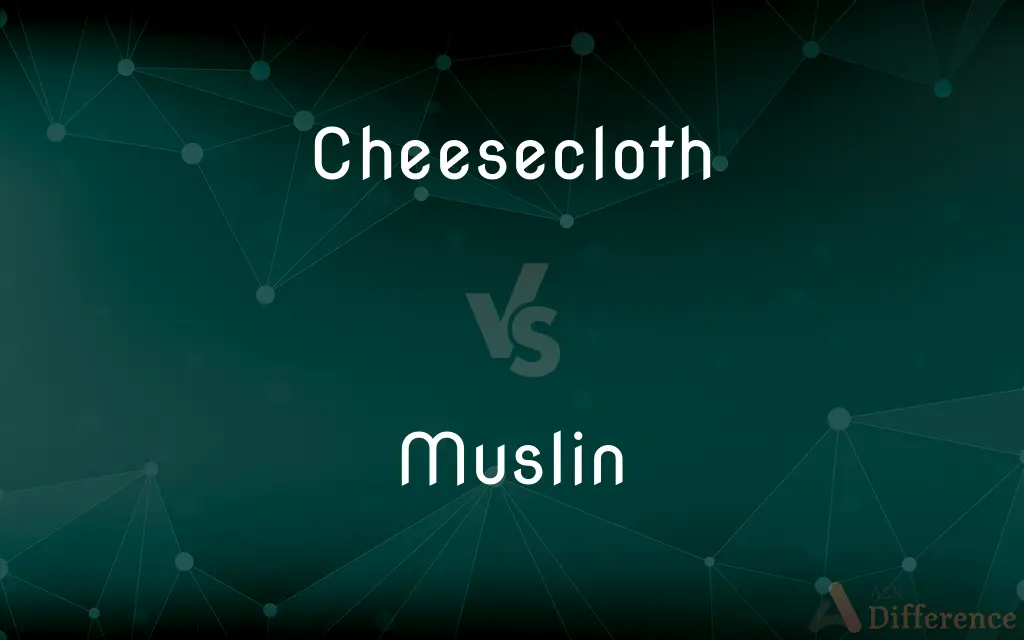Cheesecloth vs. Muslin — What's the Difference?
By Tayyaba Rehman — Updated on November 2, 2023
Cheesecloth is a loose-woven cotton cloth used in cheese-making, while muslin is a finer, plainly woven cotton fabric.

Difference Between Cheesecloth and Muslin
Table of Contents
ADVERTISEMENT
Key Differences
Cheesecloth, known for its loose weave, is commonly used in culinary settings, particularly in cheese production to drain and hold curds. Muslin, with a finer weave, serves multiple purposes, including culinary uses, but it is also a popular choice for fashion and decor.
While cheesecloth has a gauzy, mesh-like texture that allows liquids to pass through while trapping solids, muslin is denser, making it suitable for apparel where transparency is not desired. Both are made of cotton, yet the processing and final use of the cloths differ due to their distinct textures.
Cheesecloth comes in various grades indicating different weave tightness, affecting its filtering capability. Muslin, on the other hand, does not have such graded varieties but can vary in thread count and quality, impacting its softness and durability.
In the kitchen, cheesecloth is indispensable for straining stocks and making spice bags, whereas muslin can be used for similar tasks but is also preferred for making food wraps and reusable tea bags due to its finer quality.
Despite their differences, both cheesecloth and muslin are washable and reusable, highlighting their versatility in numerous applications ranging from culinary to theatrical uses, where cheesecloth can create effects like smoke and cobwebs, and muslin can serve as a paintable backdrop.
ADVERTISEMENT
Comparison Chart
Weave Type
Loose, open weave
Finer, plain weave
Primary Use
Cheese-making, straining
Sewing, dress-making, culinary uses
Fabric Density
Less dense, more transparent
More dense, less transparent
Varieties
Graded by number for coarseness
Varies by thread count and quality
Durability
Less durable due to loose weave
Generally more durable due to tighter weave
Compare with Definitions
Cheesecloth
A tool in the kitchen for making yogurt, cheese, and preserving.
He lined the colander with cheesecloth to drain the homemade yogurt.
Muslin
A lightweight cloth often used as a filter or a wrap in cooking.
He used a square of muslin to strain the chicken broth.
Cheesecloth
A porous fabric used for culinary straining and wrapping.
She bundled the herbs in cheesecloth to create a bouquet garni for the stew.
Muslin
A plain-woven, cotton fabric known for its versatility.
The tailor used muslin to create a prototype of the dress design.
Cheesecloth
A gauzy, lightweight cotton cloth used in cheesemaking.
I wrapped the lemon halves in cheesecloth to keep the seeds out of the juice.
Muslin
A fine cloth employed in pattern making in sewing.
The fashion student cut her patterns in muslin before using the actual fabric.
Cheesecloth
A versatile material used in painting and cleaning to create texture.
The artist used cheesecloth to dab paint onto the canvas for a unique texture.
Muslin
A breathable fabric preferred for making summer clothing.
She wore a muslin blouse that was perfect for the hot weather.
Cheesecloth
A cotton mesh often used in crafting and decorating.
They draped cheesecloth over the lanterns for a diffused, eerie light effect.
Muslin
Muslin () is a cotton fabric of plain weave. It is made in a wide range of weights from delicate sheers to coarse sheeting.
Cheesecloth
Cheesecloth is a loose-woven gauze-like carded cotton cloth used primarily in cheese making and cooking.
Muslin
Lightweight cotton cloth in a plain weave
She folded the dress in layers of clean muslin
Strain the fruit pulp through a muslin cloth
Cheesecloth
A coarse, loosely woven cotton gauze, originally used for wrapping cheese.
Muslin
Any of various sturdy cotton fabrics of plain weave.
Cheesecloth
A loosely woven cotton gauze, originally used to wrap cheese, but now used for various culinary tasks and by farmers to shade crops and keep birds off.
Muslin
(textile) Any of several varieties of thin cotton cloth.
Cheesecloth
A thin, loosely-woven cotton cloth of a gauze texture, such as is used in pressing cheese curds.
Muslin
(US) Fabric made of cotton, flax (linen), hemp, or silk, finely or coarsely woven.
Cheesecloth
A coarse loosely woven cotton gauze; originally used to wrap cheeses
Muslin
Any of a wide variety of tightly-woven thin fabrics, especially those used for bedlinen.
Muslin
(US) Woven cotton or linen fabrics, especially when used for items other than garments.
Muslin
(countable) A dressmaker's pattern made from inexpensive cloth for fitting.
Muslin
Any of several different moths, especially the muslin moth, Diaphora mendica.
Muslin
Woman as sex object; prostitute, as in a bit of muslin.
Muslin
A thin cotton, white, dyed, or printed. The name is also applied to coarser and heavier cotton goods; as, shirting and sheeting muslins. In sheeting, muslin is not as finely woven as percale.
Muslin
Plain-woven cotton fabric
Muslin
A material used in theater backdrops and set design.
The set designer painted the muslin backdrop to look like an ancient wall.
Common Curiosities
What is cheesecloth made of?
Cheesecloth is made of cotton and characterized by its loose, open weave.
What are the common uses of muslin?
Muslin is used in sewing, pattern making, culinary arts, and as a fine filter.
Is muslin suitable for straining?
Yes, muslin can be used for straining, though it is finer than cheesecloth.
Can cheesecloth be used multiple times?
Yes, cheesecloth can be washed and reused, depending on the task it was used for.
How is cheesecloth graded?
Cheesecloth is graded by its number of threads per inch, indicating its tightness.
Is cheesecloth only used in the kitchen?
No, cheesecloth is also used in crafting, painting, and sometimes in theatrics.
Can muslin be used in cheese-making like cheesecloth?
Muslin can be used in cheese-making, but it may not allow as much whey to drain due to its tighter weave.
Does the quality of cheesecloth affect its use?
Yes, higher grades of cheesecloth can strain finer particles and are more durable.
How do you clean cheesecloth after use?
Rinse thoroughly, wash with mild detergent, and let air dry.
Can muslin be dyed or painted?
Yes, muslin takes dye and paint well, which is why it's used for backdrops.
What is the main difference between cheesecloth and muslin in texture?
Cheesecloth has a more open, gauzy texture, while muslin is smoother and finer.
Are there different types of muslin?
Yes, muslin comes in different weights and qualities, from delicate to coarse.
Why choose muslin over cheesecloth for dressmaking?
Muslin is smoother and less transparent, making it more suitable for garments.
cheesecloth or muslin?
Cheesecloth is typically used for spice bags as it allows better circulation of flavors.
What should I consider when selecting muslin for culinary use?
Consider the fabric's density and if you need it for straining or wrapping.
Share Your Discovery

Previous Comparison
Antler vs. Rack
Next Comparison
Appellable vs. AppealableAuthor Spotlight
Written by
Tayyaba RehmanTayyaba Rehman is a distinguished writer, currently serving as a primary contributor to askdifference.com. As a researcher in semantics and etymology, Tayyaba's passion for the complexity of languages and their distinctions has found a perfect home on the platform. Tayyaba delves into the intricacies of language, distinguishing between commonly confused words and phrases, thereby providing clarity for readers worldwide.















































